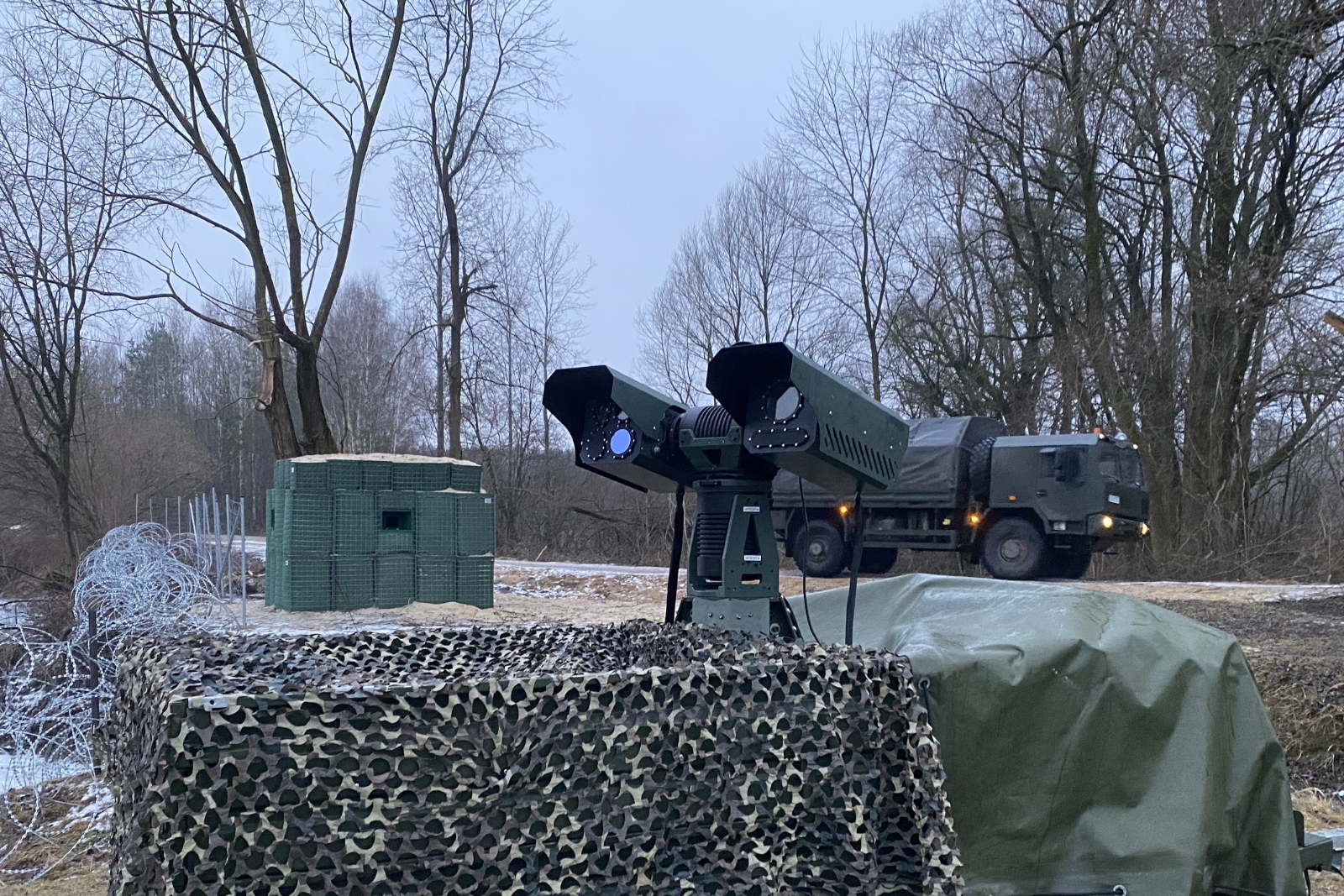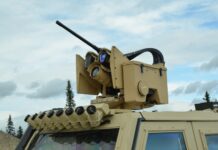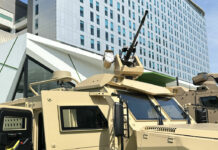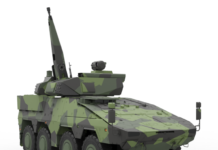As the UAV threat continues to proliferate, thanks primarily to the low cost of entry provided by commercial drone manufacturers, they continue to make their presence felt on the battlefield. Dealing with these threats is very possible, but the solutions pose economic as well as technical challenges. As such, the C-UAV market is now teeming with competitors offering various solutions for different niches and user requirements. Doug Richardson examines some of these solutions on offer in Europe.
In December 2020, the publication NATO Review warned that “all competitors, from peers to terrorists and non-state actors, are including drone technologies in their standard tactics and concept of operations, challenging Allies’ traditional air superiority in most conflicts.” Since then, the potential threat posed by unmanned aerial vehicles (UAVs) has increased. A May 2023 report Making the Most of the European Sky Shield Initiative by the Center for Strategic & International Studies (CSIS) described how in a survey researchers had conducted with 16 unidentified “European defense experts” in February 2023, most responders had singled out UAVs as an important target set that needs to be addressed.
In many cases, UAVs are custom-designed military platforms systems, but there is a growing trend to weaponise commercially-available hardware such as the relatively-inexpensive drones flown by enthusiasts. Press reports tend to describe any form of UAV as being a ‘drone’, but the term is best used for commercial and consumer systems, which tend to be smaller and less sophisticated than military UAVs.
Finding an effective counter to the UAV threat has not been easy. Although a growing range of counter-UAV (C-UAV) systems has been shown at recent defence exhibitions, a Joint Air Power Competence Centre report published in January 2021 described C-UAV as “a wicked problem”, and noted that “it involves a multitude of aspects and problems for which solutions are not trivial or not practical in many typical scenarios.” Such factors have not deterred companies working in the C-UAV field. With hundreds of systems now being offered by companies in Europe and beyond, all that this article can do is to use a small number of these to illustrate different approaches to countering the UAV.

Credit: VoidWanderer, via Wikimedia Commons
Methods of Detection
Potential methods of detecting UAVs include radar, passive RF sensors designed to detect transmissions to or from the intruder (such as direction finders), acoustic sensors able to recognise its sound signature, and optoelectronic systems intended to recognise its presence against a sky or terrain background. Data fusion can be applied to the simultaneous output from several types of sensor in order to achieve a higher possibility of detection that is available from a single source.
Passive RF
Passive RF sensors try to detect and analyse any RF signals used for communications between the air vehicle and its ground-based control station. The characteristics of such uplink or downlink transmissions may serve to identify the specific model of UAV.
Developed by the Ukrainian company Proximus, the Bukovel-AD was designed to use a passive RF sensor to detect UAVs at ranges of up to 100 km, then when the intruder was less than 20 km away to jam data transmission between the air-vehicle and its controllers. Available in vehicle or tripod-mounted form, it is currently in service with the armed forces of Ukraine and Morocco. During the 2014-2022 war in Donbass, the system was able to bring down Russian Orlan-10 UAV.
Active Radar
Large UAVs can be detected by existing radar systems, but smaller examples may prove hard to distinguish from radar clutter. Many types of small air-surveillance radar are useable against UAVs, but a more specialised radar may be needed to detect the smallest threats. According to the Spanish company Advanced Radar Technologies, its Midrange 3D radar uses a 3D multi-beam antenna system, an additional high-power amplifier stage, and a 1 Hz scan rate to detect, track, and classify objects with a radar cross section (RCS) of less than 0.01 m2, such as micro quadcopters and micro fixed-wing UAVs. This level of performance makes it suitable for unmanned aircraft traffic management (UTM), and for the C-UAV role, says the company.
Most radars used for the detection of UAVs will themselves be targets for enemy ESM, since their signal will indicate the presence and approximate location of C-UAV defences. However, the Finnish company Patria includes UAVs in the potential list of targets for its MUSCL passive radar system. Designed to exploit existing FM radio and DVB-T/T2 TV broadcasting signals as illuminators of opportunity, MUSCL uses passive coherent location (PCL) technology to detect, locate and track targets. Target location is obtained by measuring both the time-difference-of-arrival (TDOA) of the signal reflected by the target and the direct path signal, as well as the target azimuth angle of the arrival. This angular measurement capability allows targets to be tracked even if only a single transmitter is available to be exploited. According to Patria, the use of operating frequencies lower than those used by conventional air surveillance radars improves the system’s ability to track aerial targets that exploit stealth technology, and those that are small and fly at low speeds and low altitudes.
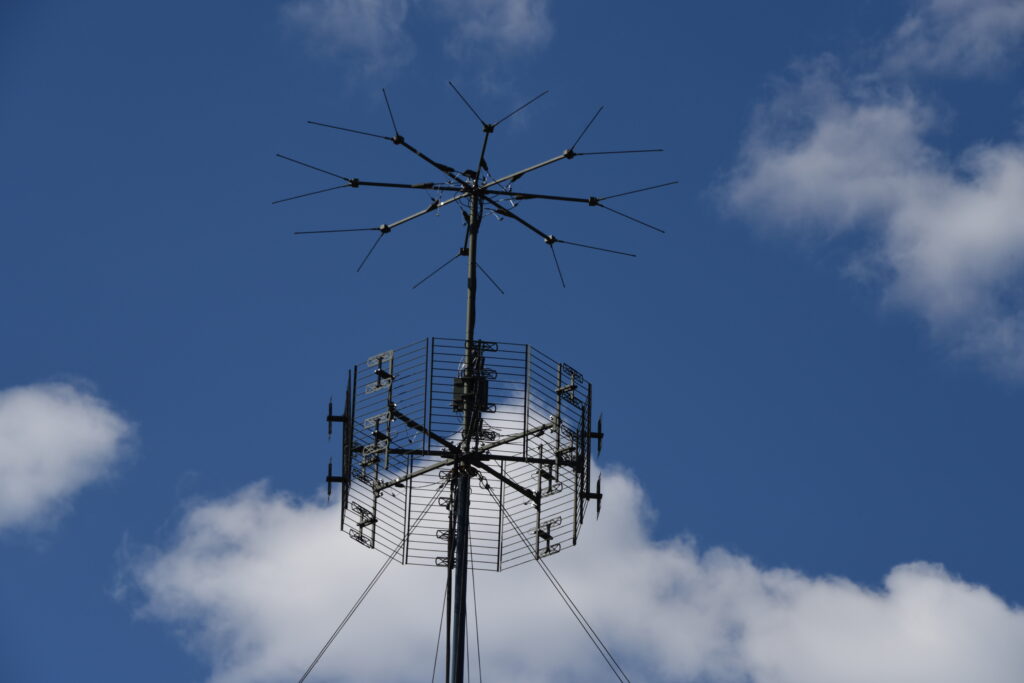
Credit: Patria
Optoelectronics
Deployed in the form of multiple fixed cameras, or mounted on a rotating gimbal, then paired with suitable software, optoelectronic sensors operating in the visible-light or infrared bands can automatically detect and track UAV targets including those that do not emit RF energy. They can also be used to identify potential targets initially detected by radar or other sensors.
The Estonian companies Milrem Robotics and Marduk Technologies have teamed to create a mobile autonomous C-UAV platform that combines the Milrem Robotics THeMIS unmanned ground vehicle and the Marduk Shark optoelectronic C-UAV system. While many current C-UAV systems are intended to intercept and jam RF communications between a UAV and its operator, Marduk Technologies believes that current advances in computer-vision technology will allow UAVs to conduct their mission in conditions of radio silence. Such threats can best be countered by using a combination of sensor fusion and machine-learning algorithms to detect, classify and target loitering munitions and other small threats at ranges of up to 2 km, says the company.
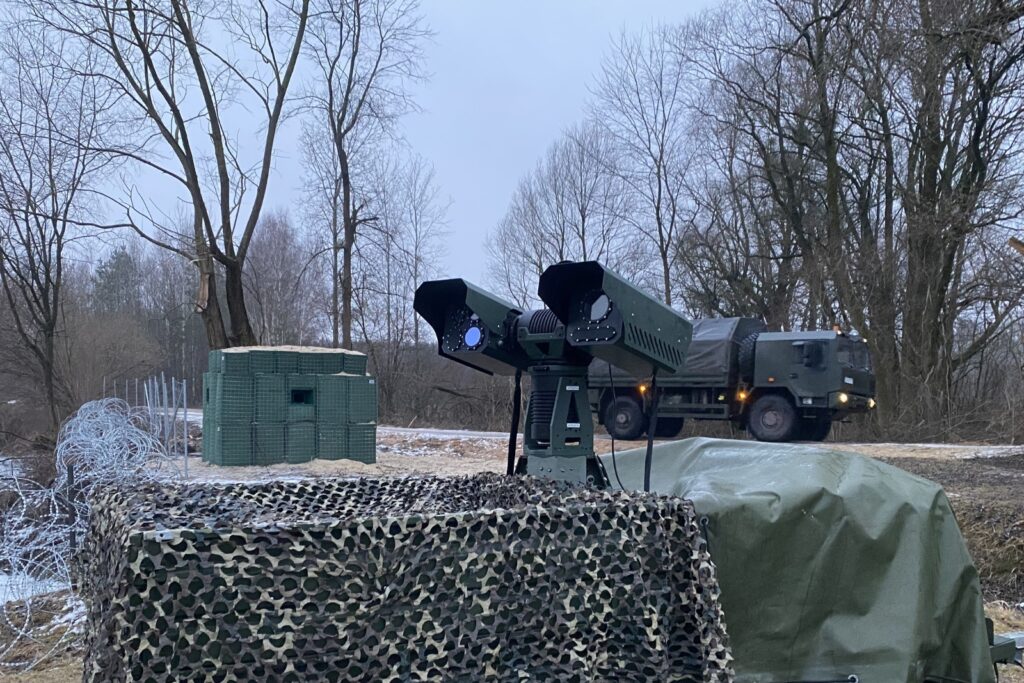
Credit: Marduk
Acoustics
Spinning propellers and the motors that drive them create sounds that can often be unique to that particular combination. Acoustic sensors based on high-sensitivity microphone arrays and audio analysis techniques can not only detect the presence of a UAV by its sound signature, but can automatically compare this to a library of acoustic signatures in order to determine what type of air vehicle the intruder is.
Given a number of spatially-separated microphones, triangulation can be used to determine the approximate location of the intruder, while Doppler shift in sound frequency of the source signal over a period of time may allow its approximate speed and direction to be assessed. However the performance of acoustic sensors can be degraded by the presence of background noise, and by weather.
Microflown AVISA offers Skysentry, an acoustic sensor array able to track drones ranging from toy-shop multicopters to larger UAVs of fixed-wing configuration, as well as manned platforms such as helicopters and propeller-driven aircraft. Its basic senor package is the ‘Castle’, which consists of an array of four hard-wired and spatially distributed acoustic multi mission sensors, an acoustic master (AMR), and a weather station. It normally also incorporates two satnav receivers used to determine the unit’s position and heading. A single Castle unit can typically be deployed by one person in less than 10 minutes. In practice, several can be deployed to create a network of sensor posts which are either hard-wired, or interconnected by radio.

Credit: Microflown AVISA
The system divides the entire acoustic frequency spectrum into what the company terms ‘frequency bins’. The direction of arrival for potential threat signatures is determined for a number of frequency bins. The more bins that point in a same direction, the higher the likelihood that this indicates the presence of a potential airborne threat.
Detection range will depend on the type of drone, weather conditions such as wind speed and wind direction, the intrinsic noise level of target. Initial tests have demonstrated detection range up to 250 m for a small (2 kg) quadcopter drone and up to 1 km for a fixed-wing drone of similar weight. While the system can be deployed as a self-contained C-UAV system, it has the interfaces needed for integration in a multi-sensor C-UAV system.
Potential Counters
While there is no ‘one size fits all’ solutions to the problem of countering UAVs, the alternatives to shooting down the intruder must include jamming the RF links used by the target in order to bring its mission to an end, taking electronic control of the intruder and ordering a change of course or even an unplanned landing, or even physically capturing it. There should be a minimal risk of collateral damage, while in a world where the number of UAV incidents seem likely to keep rising, a low cost per engagement is to be desired.
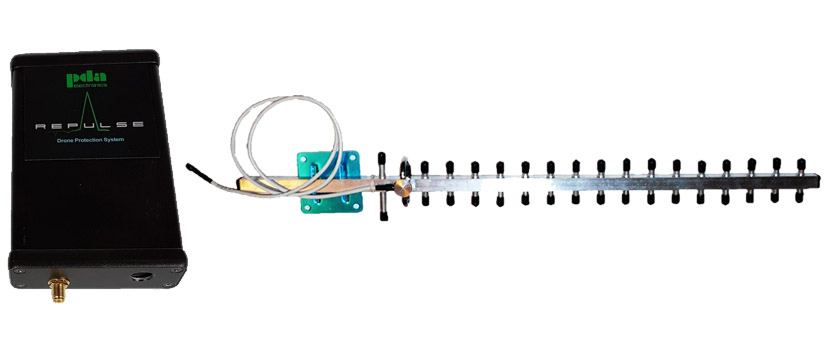
Credit: Repulse
The most obvious threat of public safety is the operation of UAVs within air lanes or into the airspace over an airport, creating a risk that the device could collide with a fixed or rotary-winged aircraft either because its operator is sufficiently distant to not be aware of aircraft, or could even have lost control of the UAV due to a failure of the communications link between the UAV and the user’s control unit. From 19-21 December 2018, hundreds of flights had to be cancelled at London’s Gatwick Airport following reports that unidentified UAVs were flying close to the runway.
Other threats to public safety threats could be posed by UAV flying over large groups of people attending function such as a political rally or major sport, or over disaster areas caused by fire or bad weather. In most counties it is illegal to drive a road vehicle while under the influence of alcohol or drugs, but we must recognise the possibility of a UAV operator flying his air vehicle in the same undesirable condition.
Inevitably there is a ‘grey area’ between a military UAV taking part in combat operations, and the non-military situations listed above. A UAV attempting to fly over security facilities such as military bases may require a harsher response than that used against one flying over a sports event.
Jammers
When jamming interferes with the RF connection between a UAV and its control station, or denies it the use of GNSS, the UAV may respond with in a pre-programmed manner such as hovering in place, attempting to land in place, or attempting to fly to a user-defined location, such as their original launch location.
Kirintec is the UK company whose C-UAV systems seem to have been named by someone with an interest in archery. Longbow+ is a 41 kg modular jammer designed for use on land and maritime platforms and in static locations. It covers three frequency bands – low-band (20-520 MHz), mid-band (500 MHz – 2.7 GHz), and high-band (2.4-6 GHz) with an output power output of up to 450 W. Intended as a smaller tactical solution, Sky Net Recurve Max+ covers the same frequency bands as the vehicle installed system, but weighs only 22.6 kg. Output power is 90 W. While Longbow+ uses an omnidirectional antenna, Recurve Max+ can operate with omni-directional antenna, but directional low-, mid- and high-band antennas are available if required.
With commercially-available drones now posing a potential threat to public events, fixed-site civil, political, or military facilities, or being used to smuggle contraband such as drugs, mobile phones, and even firearms into secure facilities such as prisons, there is a need for jammers custom-designed for this class of target. One example is the MinKa (fixed) C-UAV Jammer offered by the French company KEAS, along with its MinKam (mobile) equivalent. Both cover all the frequency bands used by commercial drones, as well as GNSS systems, and are available in three variants offering detection only, jamming on detection, and continuous jamming respectively.
The UK-based Repulse company has developed its Repulse 24 unit for applications that include internal installation on an aircraft or helicopter on order to provide a forward-facing beam of 2.4 GHz jamming at ranges of up to 1 km. If fitted with an optional Yagi antenna, the unit could counter drones at ranges of 8 km or more, says the company, so could be used in ground-based form to protect aircraft on approach or just after take-off.
Many manufacturers offer small man-portable jammers configured for use from the shoulder. A typical example is the EDM4S SkyWiper announced by the Lithuanian company NT Service at the 2019 Security and Counter Terror Exhibition in London. Made of aluminium, and shaped like a rifle, it weighs 5.5 kg, and incorporates sighting optics up to six antennas. The default configuration has four antennas – two for the 2.4 GHz and 5.8 GHz frequency bands, one for the 1.5 GHz band used by GPS, and one for the 1.5 GHz band used by GLONASS. All four antennas have an output power of 10 W. Aimed at its target, and activated at a range of 3-5 km, the EDM4S is intended to disrupt the aerial vehicle’s communications and satellite navigation capabilities.
The UK company Blighter Surveillance Systems has teamed with Chess Dynamics to offer the AUDS (Anti-UAV Defence System). Its own passive electronically scanned array (PESA) radar uses frequency modulated continuous wave (FMCW) technologies to detect small UAVs in all weather conditions. Modern plastic-bodied drones have a very low RCS, but according to Blighter, the radar’s Ku-band operating frequency allows it to detect the radar energy reflected by small structural elements such as control wires, the battery pack, the motor, and the on-board communications system. AUDS uses what the company describes as D3 (Digital Drone Detection) technology intended to extract the tiny radar reflections from these components even when the target is flying close to the ground or near buildings (conditions where clutter reflections are relatively large).
Chess Dynamics provides the Hawkeye Deployable System and EO Video Tracker used by AUDS. This combines a high definition (HD) daylight camera and a medium-wave infra-red (MWIR) thermal imager that uses sophisticated image-processing electronics to deliver good imaging performance plus a narrow field-of-view electronic-zoom capability.
A non-kinetic radio frequency (RF) subsystem with a directional antenna is intended to selectively interfere with the target’s command and control channels. It uses antennas with a stated beamwidth of 20°, and targets the five threat ‘bands’ commonly used by UAVs – 433 MHz, 915 MHz, 2.4 GHz, 5.8 GHz and the GNSS frequencies.
Given the repeated use of UAVs in its conflict with Russia that began in 2014 with the Donbass war and the Russian occupation of Crimea, it is hardly surprising that Ukraine has developed C-UAV systems. The KVS ANTIDRON system offered by Kvertus Technology in Kyiv combines the company’s KVS AD-1 detection system and Vortex Antidron jammer into a single integrated system. According to the manufacturer, it has a detection radius of up to 2 km, and a jamming radius of up to 2 km. Total output power is 500 W, and the system covers all the frequency bands used for remote radio control and video transmission, plus the GPS L2 frequency of 1,227 MHz, and the L1 frequencies of both GPS and GLONASS at 1,575 – 1,620 MHz.
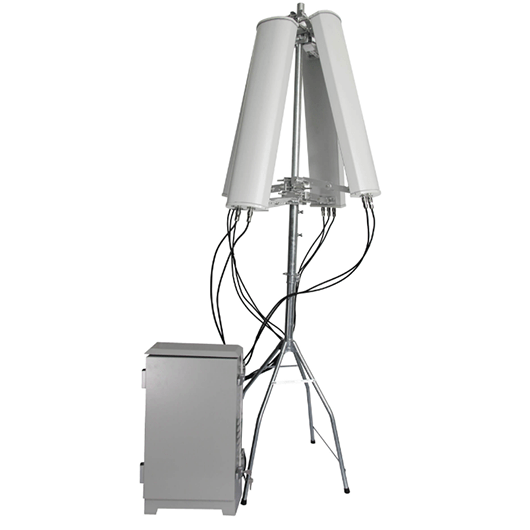
Credit: Kvertus Technology
Tracking a small slow-flying air vehicle is a significant challenge for radars, particularly if the target is able to hover. To solve this problem, the Germany company ESG has integrated the Airscout Verify slew-to-cue system developed by Walaris into its own Elysion automated drone detection system. Airscout Verify uses image-recognition algorithms to search the video output of the day/night vision channel of the Elysion. One a target detected by radar has been detected in the video image, Elysion automatically fuses the data derived from the video image with that from the other sensors. If the radar track is briefly lost, the system will maintain its tracking of the target via the video image. AirScout verify uses hardware-agnostic software, so can be rapidly upgraded or downgraded with different sensors or optics.
SAM Versus UAV
At the top end of the spectrum, a large and sophisticated UAVs such as the US Global Hawk can be considered by air defenders to be the equivalent of a manned aircraft, and a suitable target for current surface-to-air missile systems (SAMs). For example, on 20 June 2019 Iran used a locally developed Sevom Khordad medium-range SAM to engage and destroy a US Navy Broad Area Maritime Surveillance-Demonstrator (BAMS-D) version of the Northrop Grumman RQ-4 Global Hawk.
A defensive SAM system needs to locate and track a potential threat before it can be targeted and engagement begun. The smaller the threat’s signatures are, the later its detection will be achieved. For smaller UAVs, the ranges and altitudes they operate at mean that the launching point will be relatively close to the intercept point, so the engagement will essentially be a point-defence task. Under such conditions the SAM system will have little or no area-defence capability.
European-developed SAM systems are reported to have proven combat-effective during the current conflict between Ukraine and Russia. Ukrainian President Volodymyr Zelenskyy has described the Diehl Defence IRIS-T “a really effective system”, and the Ukrainian Air Force claimed a 100% success rate when using the system against a Russian cruise missile attack on 31 October 2022. Ukraine took delivery of its first two Kongsberg Defence & Aerospace NASAMS batteries early in November 2022, and in April 2023 stated that the system had destroyed more than 100 Russian missiles and UAVs.
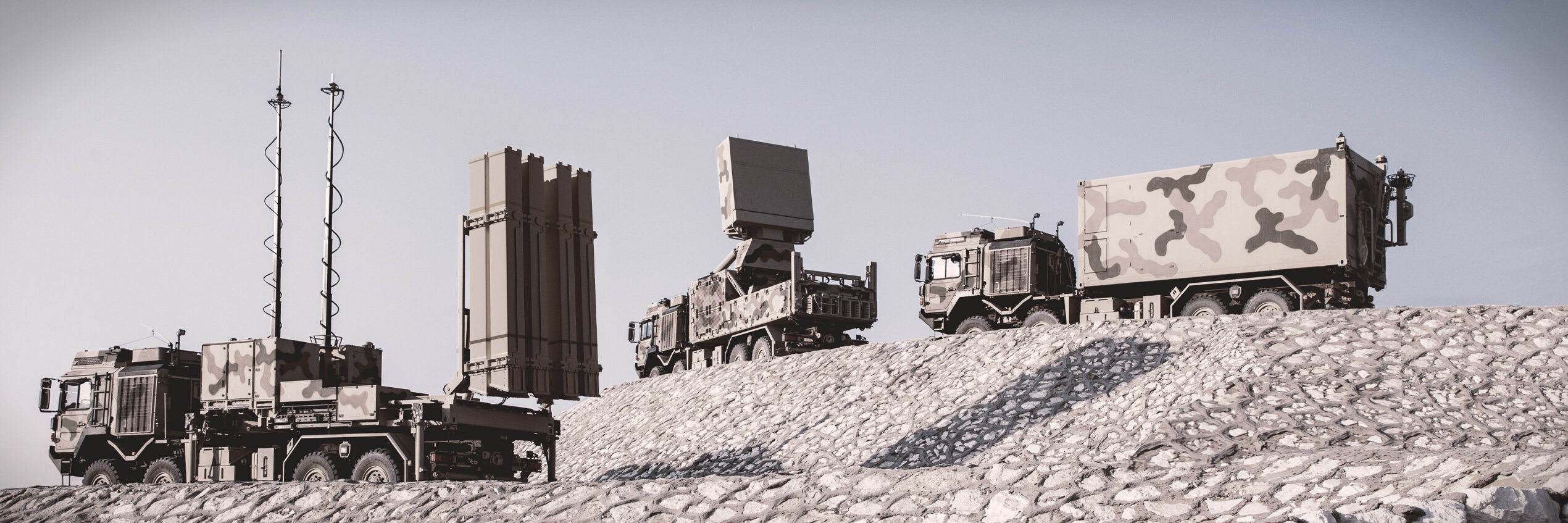
Credit: Diehl Defence
Medium-sized UAVs may still be viable targets for medium-range or short-range SAMs, but smaller UAVs are likely to be considerably less expensive than this class of missile, making them affordable for use in large numbers for armed forces or even militant groups such as the Houthis. Their low cost makes them useable in quantities that would soon run down the defender’s SAM stocks.
As this article was being finalised, on the night of 27/28 May Russia launched what was then its heaviest-ever UAV attack on Ukraine, which claimed that 52 out of the 54 Iranian-made air vehicles that had entered Ukrainian airspace had been shot down. One possible reason for attacks on this scale might be an attempt to draw down Ukraine’s stock of defensive missiles.
On 30 May, Russia reported that the Moscow area had been attacked by eight UAVs. Five had been shot down by Pantsir-S surface-to-air missile systems, and three had lost control and deviated from their intended targets as the result of defensive electronic-warfare.
Gunfire – the Low-Cost Solution
Conventional anti-aircraft weapons are one potentially low-cost method of subjecting UAV targets to defensive fire. The era in which low-flying seemed to promise survivability for strike aircraft saw fast-firing anti-aircraft guns being teamed with co-located or even on-mount radars, so these now-elderly weapons could achieve a new lease of life in the C-UAV role. When dealing with small UAVs, even small-arms fire may prove effective. The Kyiv police have released video footage showing a group of its officers using full-automatic fire from assault rifles to engage an unidentified Russian UAV.
According to a November 2022 report by the UK’s Royal United Services Institute (RUSI), gun systems are a more effective method of downing UAVs than missiles “due to the much lower cost per engagement and higher availability of ammunition compared with SAMs and MANPADS”. It went on to suggest that “A relatively simple new product that combined a small counter-UAV AESA radar with an attachable predictive aiming reticule sight is one option that, if possible, would offer a way to significantly enhance the capability of Ukraine’s many traditional anti-aircraft guns such as ZSU-2-23 and 14.5-mm/12.7-mm heavy machine guns against Shahed-136.” It also reported that “legacy Soviet and Russian self-propelled anti-aircraft guns (SPAAGs) such as Shilka and Tunguska also struggle to reliably shoot down the Shahed-136, although the German Gepard is highly effective.”

Credit: KMW
By 20 September 2022 Ukraine had received 30 Gepards from Germany, plus 6,000 rounds of ammunition for the vehicle’s twin 35 mm cannons. A few days later it reported having taken delivery of about 50,000 Norwegian-made 35 mm rounds. In December 2022, Germany recovered seven additional Gepard vehicles that had been scrapped, and began the task of refurbishing these for delivery to Ukraine. Detection range of the Gepard’s radar against an Iranian Shahed-136 loitering munition is reported to be around 16 km. According to a Ukrainian Gepard operator interviewed for a TV news programme, downing a Shahed-136 typically requires the firing of only six rounds – three per barrel.
During the NATO Non-Lethal Technology Exercise (NNTEX-C) held in Sardinia from 4-24 March 2022, FN Herstal demonstrated a container-based perimeter defence solution that incorporated radar and passive RF sensors, and a combination of both soft- and hard-kill effectors. A smart and scalable signal jammer could be used as an initial response once the UAV had been detected, but if a hard kill was required, the system could use a deFNder Light Remote Weapon Station fitted with either an FN MINIMI 5.56 mm or 7.62 FN MAG 7.62mm machine gun, or a deFNder Medium weapon station armed with 12.7 mm weapons such as the FN M2HB-QCB or FN M3R, or even a 40mm Automatic Grenade Launcher with compatible with air-burst munitions.
The Way Ahead
November 2021 saw NATO conducting C-UAV Technical Interoperability Exercise 2021 (TIE21). Held at Lieutenant General Best Barracks in Vredepeel in the Netherlands, this brought together military, scientific and industrial specialists in order to test emerging technologies and integrate systems able to counter small drones. “Malicious actors have made use of low-cost hobby drones in recent years, creating a potential security threat to Allies,” said Dr Cristian Coman, who leads counter-drone activities at the NATO Communications and Information Agency (NCI Agency). “The misuse of small drones represents a significant and growing risk to operations and day-to-day defence activities for NATO and nations.”
Goals of the TIE21 testing included identifying a minimum set of standards relevant for the NATO C-UAV domain, demonstrating interoperability between C-UAV components and fully integrated systems in NATO-relevant scenarios; and evaluating C-UAV technical architectures. The exercise was also intended to explore ‘zero-second integration’ – the ability to link various sensor and detection systems together instantly without the need for software or hardware adaptations.
A follow-on Technical Interoperability 2022 (TIE22) took place at Vredepeel during 13 and 23 September of last year. It involved more than 30 companies and organisations, and demonstrated the capability of their C-UAV systems during the live testing scenarios. Two prototype UAV-detection systems were also deployed to help the NATO Communications and Information (NCI) Agency to understand the commercial technology involved and see if it can support the alliance’s evolving requirements.
Two systems deployed during the exercise had been developed by the NCI agency. One was a modified version of its ARTEMIS system seen at TIE21, the other was a Drone IDentification System (DroIDs). Both use machine learning algorithms to detect and classify drones. According to Major General Göksel Sevindik, the Chief of Staff at the NCI Agency, “It is an essential tool to help the Agency understand the technology being used in the market and to identify areas where NATO would benefit from developing standards around [C-UAV] systems.”
Dr Cristian Coman was optimistic about the value of the trials. “Through the new innovations tested at this exercise, the Agency sends the message of TIE22 – that [C-UAV] shall be integrated with existing air defence in order to guarantee NATO’s airspace remains safe.”
Too Many Players?
A 2019 research paper on counter-drone technology by Bard College’s Center for the Study of the Drone listed 537 C-UAV systems, but it remains to be seen whether the growing use of UAVs creates a market for C-UAV systems that is large enough to support so many companies and products. As current conflicts see UAVs being pitted against C-UAV systems, the results could show which of the latter are the most combat-effective. Some shake-out of the current range of companies and products seems inevitable.
Doug Richardson


